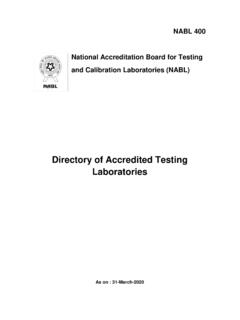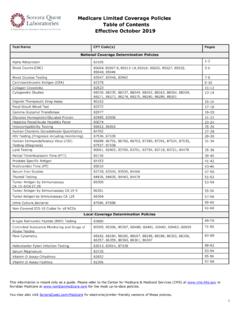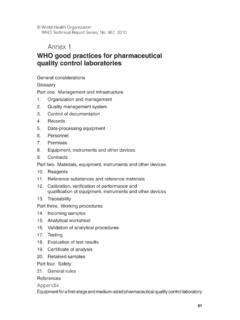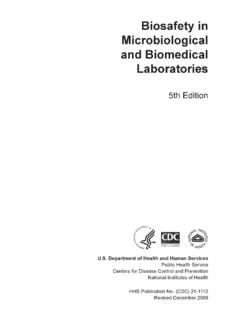Transcription of Forensic Laboratories: Handbook for Facility Planning ...
1 Forensic laboratories : Handbook for FacilityPlanning, Design, Construction, and MovingSome figures, charts, forms, and tables are not included in this PDF view this document in its entirety, order a photocopy from Department of JusticeOffice of Justice ProgramsNational Institute of Justice DEPARTMENTOFJUSTICE OFFICEOFJUSTICEPROGRAMSBJANIJOJJDPBJSOVC N ational Institute of Standards and TechnologyDepartment of CommerceNational Institute of JusticeDepartment of JusticeRESEARCH REPORTF orensic laboratories : Handbook for FacilityPlanning, Design,Construction, and MovingForensic laboratories : Handbook for FacilityPlanning, Design,Construction, and MovingU. S. Department of JusticeOffice of Justice Programs810 Seventh Street , DC 20531 Janet RenoAttorney Department of JusticeRaymond C. FisherAssociate Attorney GeneralLaurie RobinsonAssistant Attorney GeneralNo l BrennanDeputy Assistant Attorney GeneralJeremy TravisDirector, National Institute of JusticeOffice of Justice ProgramsNational Institute of JusticeWorld Wide Web Site:World Wide Web Site: Department of JusticeOffice of Justice ProgramsNational Institute of JusticeForensic laboratories : Handbook for FacilityPlanning, Design,Construction, and MovingLaw Enforcement and CorrectionsStandards and Testing ProgramCoordinated byOffice of Law Enforcement StandardsNational Institute of Standards and TechnologyGaithersburg, MD 20899 0001 April 1998 NCJ 168106 National Institute of JusticeJeremy TravisDirectorThis technical effort to develop this report was conducted underInteragency Agreement No.
2 94 IJ R 004, Project No. 97 report was prepared with the assistance of the Office of Law Enforcement Standards(OLES) of the National Institute of Standards and Technology (NIST) under the direction ofAlim A. Fatah, Program Manager for Chemical Systems and Materials, and Kathleen , Director of OLES. Editorial support was provided by Aspen Systems work was sponsored by the National Institute of Justice,David G. Boyd, Director, Office of Science and and conclusions of the research reported here are those of the authors and donot necessarily reflect the official position or policies of the Department of National Institute of Justice is a component of the Office of Justice Programs, which also includes theBureau of Justice Assistance, Bureau of Justice Statistics, Office of Juvenile Justice and DelinquencyPrevention, and Office for Victims of LABORATORY Facility HANDBOOKF oreword .. 1 Technical Working Group .. 3 Executive Summary.
3 5 Overview .. 7 Planning .. 9 Design .. 19 Construction .. 51 Moving .. 59 Appendixes .. 71 Appendix I: Description of Spaces by Laboratory SectionsAppendix II: Laboratory Design Standards and ModulesAppendix III: Forensic Computer ExaminationLaboratory Statement of WorkAppendix IV: Move-in PlanAppendix V: Statement of Work for theCommercial Moving ServicesReferencesTable of Contents1 Forensic LABORATORY Facility HANDBOOKF orewordAs president of the American Society of Crime Laboratory Directors (ASCLD) during1995 96, I received numerous requests for information on many topics. Information onforensic laboratory design was one of the more frequently requested need for a document that dealt with the many aspects of building a new labora-tory was obvious. I requested assistance from Dr. Richard Rau at the National Institute ofJustice to develop such a document. Under Dr. Rau s direction and through the leadershipof Kathleen Higgins, Director, Office of Law Enforcement Standards (OLES), this projectwas funded by the National Institute of Standards and Technology/OLES.
4 Additionally,they provided support and direction throughout the development of this document, Forensic laboratories : Handbook for Facility Planning , Design, Construction,and Moving, is the product of a 2-day seminar where 23 professionals met, divided intofour groups, and created this Handbook . The Handbook is not a standard but a resourcefor those faced with building a new Facility or the redesign of an existing Facility . Eachgroup had its own style, so each section has its own unique format. It is our hope that thisdocument will help laboratory managers maximize organizational efficiency, ensure theeconomical expenditure of resources, and develop a safe, secure, and well-designedfacility. We hope that the resulting facilities will provide adequate space for forensicscientists to perform their very important tasks today and will include adaptability fortomorrow as technologies appreciate the time and effort the committee members and participants have given tothis project, the work of the outside reviewers from Harley Ellington Design, and theeditorial support of Aspen Systems Corporation.
5 * * * * *One committee member, Dr. William J. Bill Hartner, who has served the forensicscience community for 37 years, passed away on February 28, 1997. Everyone deeplymourns his passing and applauds his personal achievements and the tremendous impacthe had on Forensic science. He was past president of ASCLD, 1993 94, and was com-mander of Metro-Dade s Crime Laboratory Bureau, where he had served since therefore dedicate this document to the wonderful memory of :Dr. William J. HartnerFebruary 10, 1935 February 28, 1997 Carrie Morgan WhitcombPast President 1995 96 ASCLD3 Forensic LABORATORY Facility HANDBOOKT echnical Working GroupVictor CardonaSmith, Hinchman & GryllsWashington, G. DeBoerEarl Walls AssociatesSan Diego, CaliforniaDr. Alim A. FatahNIST/OLESF rank Fitzpatrick**Orange CountySheriff/CoronerForensic Science ServicesDr. William Hartner*Laboratory BureauMetro-Dade PoliceDepartmentKathleen M. HigginsNIST/OLESDr.
6 Mitchell HollandArmed Forces DNAI dentification LaboratoryRobert Horn*Crime LaboratoryNew York State Police(Retired)Robert A. JarzenSacramento CountyLaboratory of ForensicServicesJohn KlostermanIllinois State PoliceForensic Sciences CommandJames L. McClarenRuth and Going, & Wilson, MountAIAS mith, Hinchman &Grylls Southwest Richard RauNational Institute of JusticeOffice of Scienceand TechnologyDr. Dennis ReederNIST/Chemical Science andTechnology LaboratoryBiotechnology DivisionEarl RobertsFBI LaboratoryDr. Carl M. SelavkaNew York State Division ofCriminal Justice ServicesOffice of Forensic ServicesMichael R. SominEarl Walls AssociatesSan Diego, CaliforniaRich Tanton*Palm Beach Sheriff sDepartmentCrime LaboratoryDr. Victor W. WeednDepartment of DefenseDNA RegistryCarrie Whitcomb* Postal InspectionService Crime LaboratoryJoseph WichmannIllinois State PoliceJoliet Forensic ScienceLaboratoryDan WierecWalsh ConstructionDr. Richard WilkNew York City PoliceLaboratory*Past President, ASCLD**President-elect, ASCLD5 Forensic LABORATORY Facility HANDBOOKE xecutive SummaryThe measure of a Forensic laboratory s success is how wellit meets the current and future needs of the and building a Forensic laboratory is a complicated undertaking.
7 Designissues include those considerations present when designing any building, with enhancedconcern and special requirements involving environmental health and safety,1 hazardousmaterials, management, operational efficiency, adaptability, security of evidence, preser-vation of evidence in an uncontaminated state, as well as budgetary help laboratory directors get through the process, the National Institute of Justice(NIJ), the National Institute of Standards and Technology (NIST)/Office of Law EnforcementStandards (OLES), and the American Society of Crime Laboratory Directors (ASCLD) helda joint workshop November 13 14, 1996 at NIST in Gaithersburg, Maryland, to developguidelines for Planning , designing, constructing, and moving crime guidelines serve as a general tool to which Forensic laboratory directors can referwhen considering building a new laboratory or refurbishing an existing one. There is notone universally correct plan for Forensic laboratory design.
8 No two labs are the laboratories such as toxicology, biological science/DNA, firearms analysis, ortrace evidence have specialized needs unique to their areas of work. Ultra-clean rooms orhigher levels of containment may be required for some analytical procedures. Highestperformance standards are required for cleanliness, temperature, humidity, and vibrationcontrols to create an environment suitable for Forensic needs and functional processes are the driving factors. From the start, the scien-tists who will occupy the building should be involved with the design/build team toexplain their special requirements for the is also a key element in driving a Forensic laboratory s design and configura-tion. Crime labs must be designed with the flexibility to support adaptability and changeor risk obsolescence in a few the beginning of the process, it should be decided whether the project is drivenprimarily by needs or budget. Will the needs of the laboratory determine the budget, or isthe budget preset and the laboratory economically limited to a specific amount at the outset?
9 The technical work performed in Forensic laboratories must be able to withstand anyevidentiary challenge. When detailing the needs of the laboratory, be ready to defend thoseneeds against questions that will arise because of the cost involved. Quality laboratory serviceis expensive, and the buildings in which these services are provided tend to be expensiveas well. Cost-cutting that would jeopardize the lab s testing quality cannot be an guidelines in this Handbook are designed to empower laboratory managers toimprove their situation. They are designed to safeguard the integrity and objectives of theprofession, maximize organizational efficiency, ensure economical expenditure of resour-ces, and provide a safe working environment for LABORATORY Facility HANDBOOKThe process of constructing a new Forensic laboratory revolves around four generalactivities: Planning , design, construction, and moving. Specific activities vary within eachphase of the process, and each stage is discussed in detail in the following pages.
10 Through-out the process, from conception through opening day, careful Planning and excellentcommunication among those involved are critical to The key to a successful Planning stage is the preparation of a Needs Assess-ment/Design Program, two documents frequently combined into one that form the baselinefor the project. The Needs Assessment documents user and Facility needs, evaluates theexisting Facility , defines space requirements, and provides project cost data. The DesignProgram provides a guide to design the project, translating and expanding the NeedsAssessment into a form that will be used by architects and engineers in the design Needs Assessment/Design Program may initially be an idealized statement of require-ments that will later need to be reconciled to the actual budget or resources There is not one universally correct plan for Forensic laboratory design. Designwill vary with each laboratory s specific needs. Functional requirements of specific scien-tific disciplines, equipment, and instrumentation are a few of the variables that generatespace, dimension, and adjacency requirements that impact the overall design.















